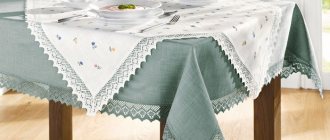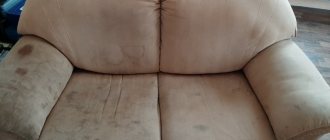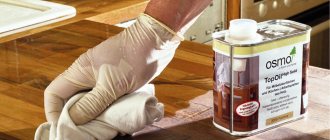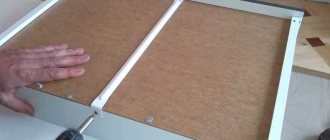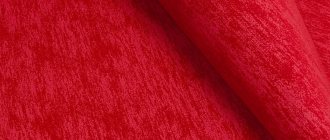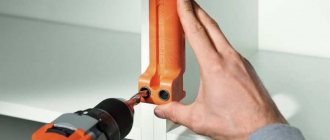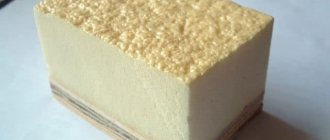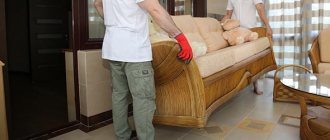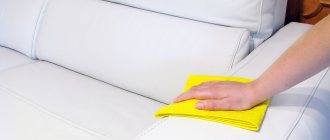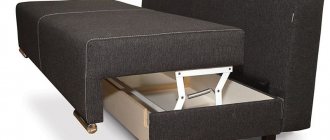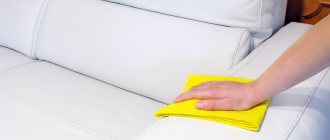Furniture polyurethane foam - PPU
Polyurethane foam (furniture foam rubber, abbreviated as PPU) is one of the most common flooring materials for the production of upholstered furniture and mattresses. Polyurethane foam is a foamed, sponge-like material obtained by mixing several synthetic polymers. A feature of modern polyurethane foams is their exceptionally high physical and mechanical properties, which in some respects are superior to all types of rubbers. Today's market offers a very wide range of different brands of foam rubber : standard, increased rigidity and hard, soft and ultra-soft, highly elastic. Each type of foam rubber has its own quality characteristics and has its own purpose in the manufacture of sofas . Polyurethane foam (PPU) is a high-volume material with a porous structure. It is used in a variety of applications - as a base for theater seats and driver's seats. Polyurethane foams are used as a filler for the production of upholstered furniture , as well as in spring mattresses, and independently in springless mattresses. The seats of sofas and armchairs made of furniture foam rubber are quite elastic and easily restore their original shape. It is comfortable to sit on such a sofa, it adapts to the shape of the body, and is easy to get up from. Due to its qualities, polyurethane foam is one of the most popular fillers for sofas . Molded polyurethane foam (PPU) is a modern high-tech environmentally friendly material, characterized by increased wear resistance and durability. The use of molded polyurethane foam allows you to achieve maximum comfort for the seats and backs of upholstered furniture - sofas and armchairs. Foam rubber purchased for the manufacture of upholstered furniture is produced on Norwegian (LAADER BERG AS) and German (FECKEN-KIRFEL and ALBRECHT BAUMER) equipment. The quality of produced foam rubber is achieved through automation of the production process and high-precision dosing of components. Strict adherence to production technology and a quality control system, as well as highly qualified personnel and high-quality raw materials from leading manufacturers, allow us to achieve the most positive characteristics of foam rubber, which makes it competitive. The filling of upholstered furniture - PPU (furniture foam rubber) - is not only characterized by low cost, but also by unique properties, which in turn determine its popularity: 1. possibility of transformation, 2. different hardness, 3. reliability, 4. durability. In addition, furniture foam rubber has other quite important properties that you need to pay attention to. They are mainly associated with direct effects on humans. PPU (furniture foam rubber) :
- does not contain substances that cause allergies, 2. does not accumulate or emit dust, 3. does not mold, 4. is safe for the health of people and animals.
All polyurethane foam used meets international hygiene standards and is treated with antibacterial, antiviral and antifungal compounds. Thus, polyurethane foam is a high-tech filler for sofas , which is characterized by increased strength and durability. In its structure, foam rubber consists of microscopic thin-walled cells filled with air. The properties of elasticity and resilience are determined by the fact that the volume of air in the total volume of the material exceeds 96%. To produce foam rubber of any type, special polyols, melamine, and fire retardants are used in the formulation so that the physical and mechanical properties (density, rigidity, cell size, elasticity, tensile strength, air permeability, residual deformation, elongation) meet the requirements of the Consumer. A sofa filled with polyurethane foam is characterized by increased strength and durability. In furniture production, various brands of foam rubber are used that have high strength indicators. They are used as filling for sofas, sofas, ottomans, armchairs and other types of upholstered furniture , which increases the comfort of the models. Each brand of polyurethane foam has its own purpose. As a rule, different brands of foam rubber are used in combination with each other. Some are for parts of furniture that do not bear the main load: the backs of sofas, armchairs, armrests. Others are for places with moderate loads during furniture use. Still others are for use in conjunction with transformation mechanisms, etc. We use mainly dense, highly elastic grades of polyurethane foam . All brands of polyurethane foam are safe, do not cause allergies and do not generate dust. These foam rubbers have hygienic certificates from the Ministry of Health, which allow their use in the furniture industry. foam rubber used also have a high degree of “air permeability”. If these brands are used correctly, this indicator indicates the possibility of a long service life of polyurethane foam , good ventilation of products and the relative comfort and durability of products. Quality indicators are consistently maintained under long-term cyclic loads, which contributes to a significant increase in the service life of furniture. They have good sound-absorbing and insulating properties. Furniture polyurethane foam is a hygienic material that, with proper care and use, will last a long time, so you don’t have to worry about the longevity of your upholstered furniture.
Key Features
Before purchasing polyurethane foam for furniture, you should familiarize yourself with its basic properties, among which density should be highlighted. This indicator is very important and determines the main characteristics, including:
- the ability to restore its original shape;
- wear resistance;
- rigidity.
Back in the middle and even the end of the 20th century, foam rubber was produced, the performance characteristics of which were much lower compared to those of modern polyurethane foam.
Sintepon
Synthetic winterizer (colloquially synthetic winterizer or sentipon, sintepon or cintepon). What it is? What is he like? Why is there so much talk about him? Is he good or bad? Is it harmful to health or not? Sintepon is an environmentally friendly elastic material for filling sofas, with a high degree of elasticity. Sintepon is used as a filler in the production of upholstered furniture - sofas, armchairs, poufs - to give seats and backs angular relief while maintaining acceptable softness and comfort. Synthetic winterizer cannot be oxidized by atmospheric oxygen for a long time. Sintepon is moisture resistant and does not absorb moisture into the fiber structure. Sintepon is a voluminous non-woven fabric made of polyester fiber. According to the method of joining the fibers, it can be thermally bonded or glued. Sintepon is an elastic-elastic material, used as a filler in the furniture industry in the production of upholstered furniture, serving to give it texture and softness. Sintepon is a flooring material made of solid acrylic fibers arranged in parallel strands. Usually a layer of padding polyester is used to cover furniture foam rubber - ppu. Sintepon is one of the most affordable fillers. Its development is not difficult and is a fast and low-cost process. Sintepon is a lightweight, elastic and voluminous non-woven material that is used for various purposes and is distinguished by its great functionality along with good thermal insulation properties. Synthetic winterizer is also used as a filler in bedding, blankets, clothing, including children's overalls. Synthetic winterizer is one of the few artificial materials that does not cause allergies to anyone. Therefore, it is also used in the children's industry as a filler for pillows and clothing. Synthetic winterizer is environmentally friendly, does not succumb to light-ozone aging for a long time, resists fungal contamination, does not absorb moisture, and is absolutely harmless. Recently, technological developments have led to the emergence of fundamentally new, high-quality synthetic holofiber products, which are in fact no longer padding polyester.
What is PPU filler in a sofa?
The PU foam filler for sofas is polyurethane foam or furniture foam rubber. It has a porous structure and consists of 90% air. It has highly elastic properties, giving softness and elasticity to the product. Thanks to these characteristics, it is actively used as padding for furniture, car seats, orthopedic mattresses, toys, dish sponges, etc.
The sofa can consist entirely of polyurethane foam and be springless, or it can be a combination one, in which several fillers are combined at once (example in the photo below).
There are two main types of polyurethane foam:
- Block - consists of large sheets of polyurethane foam, from which the manufacturer cuts out the necessary parts. The product is made from blocks of different widths and densities. Such production is less expensive in price, but after it a large amount of trimmings remains.
- Cast - this type is poured in the form of a thick foamed liquid directly into a mold of the required size. The result is a finished part and no waste. But there is also a minus: with such production, a crust appears on top of the polyurethane foam, which does not allow air to penetrate inside.
Photo: Sofas with polyurethane foam filling
Holofiber
Recently, technological developments have led to the emergence of a fundamentally new high-quality synthetic product, holofiber , which is in fact no longer synthetic padding polyester. Fiber filler is siliconized polyester balls that replace natural fluff. Holofiber is one of the most modern materials used in the production of sofas . The microstructure of holofiber is a spatial spiral (as opposed to straight fiber, as in padding polyester), which allows it to perfectly retain its shape and easily restore it. It is more hygienic than natural and other synthetic fillers, moisture-resistant, comfortable and cozy. This is an environmentally friendly, non-allergenic and non-toxic product. Fiber filler is a siliconized fiber that is formed into balls using special equipment. Thanks to this, in contrast to synthetic fiber, which, being a budget option, is tightly stuffed into the pillow and, after distribution, is a tightly stuffed object, a fiber pillow, which is stuffed loosely and allows the fiber to move inside the pillow, creates a unique shape that is suitable only for you. Holofiber is a material for filling pillows in the form of cocoon balls made of synthetic spiral fibers treated with silicone. The balls are twisted fiber treated with silicone emulsion. The fibers, intertwined with each other, form a springy structure. This property allows the fiber to quickly restore its shape after being crushed and to have high resistance to maintaining its shape over time. The fiber structure is soft, breathable, has anti-allergenic properties, does not absorb foreign odors, does not form dust, and does not form lumps. This filler is not flammable (melts, but does not support combustion). Fiber fiber has unique qualities: Durable. Finished products using holofiber quickly restore their shape after compression and are especially soft. environmentally friendly high-tech down substitute fiber does not cause allergies, which is very important for the health of modern people. Unique quality of the filler: hypoallergenic. The most important property of fiber filler is its hygiene , the ability not to absorb odors and dust, and as a result the absence of allergic reactions upon contact. Orthopedic properties. A particularly valuable quality of fiber filler is manifested in the fact that products made from it take the shape of the body. Sophisticated fiber processing technology allows them to move independently of each other, so the durable, springy structure does not fall off after prolonged use. Antistatic properties. Special antistatic treatment of our products is absolutely harmless to health. Environmental Safety. The environmental friendliness and non-toxicity of fiber fiber has secured its reputation as the most popular filler. Cozy microclimate. Fiber fiber consists of many twisted fibers, leaving air space between them, which allows the filler to “breathe”. Durability. Fiber fiber will not lose volume during operation like cheaper synthetic fillers. A product with such a filler easily returns to its original shape, even after prolonged deformation. Fiber combines important consumer properties, such as:
- do not cause allergies - hypoallergenic 2. antistatic 3. special thermal insulation and breathability 4. orthopedic, resilient, elastic, light and voluminous 5. environmentally friendly and durable 6. is an excellent substitute for natural fillers
Products using holofiber provide maximum convenience and comfort during rest and sleep. Fiber is not inferior to down in softness, elasticity and comfort, while being absolutely hypoallergenic.
Sintepooh
Synthetic fluff is the name of the filler, the cheapest of the existing fillers, which are widely used in furniture production . Today this is the best alternative to natural down. This fiber is treated with a special silicone emulsion, which gives it qualities that allow it to be called an artificial down substitute. Synthetic down is artificial down - a hollow, highly crimped siliconized fiber, 100% polyester, a single component of which in space has the appearance of a spiral spring. The length of the coil is 57 mm. These individual components, intertwined with each other, form a strong springy fiber structure. This property allows synthetic fluff to quickly restore its shape after being crushed and to have high resistance to maintaining its shape over time. The elastic, compressible structure of synthetic down is soft, breathable, and does not create a “greenhouse effect” during prolonged use. Lightness, softness, elasticity, volume, warmth, environmental friendliness, hypoallergenicity, resistance to washing and dry cleaning - these are the qualities synthetic fluff . The hypoallergenic and environmentally friendly nature of synthetic down is explained by the absence of substances harmful to human health in its production. In addition, synthetic fluff does not absorb foreign odors. Sintepooh is not afraid of water; when wet, it still retains heat. Synthetic down does not roll or fall off, which cannot be said about natural down. Synthetic down is used as a filler for backrests, armrests, decorative pillows and other upholstered furniture products .
Durafil
Durafil is a multi-layer, highly elastic, thermally bonded fabric with vertically directed fibers and an aerodynamic layout, which has low residual deformation. Durafil is a white, soft, delicate polymer. It has oriented vertical fibers and therefore works like a spring block. This soft and fluffy filler is used in the manufacture of upholstered furniture as a filler for seats, backs and armrests of sofas and armchairs. Upholstered furniture made using Durafil filler has the best consumer characteristics: the seats and backs of sofas have the ability to restore their shape after pressure or weight loading, while retaining this feature for a long time. Durafil does not cause allergies, does not absorb moisture and does not support combustion. The filler does not harbor colonies of dust mites, moths and mold fungi. The correct choice of types of flooring materials and their competent combination largely determine the quality and comfort of upholstered furniture. The following auxiliary flooring materials are used in production: batting, quilted padding, felt, spunbond and many others.
Recommendations for selection
If you are faced with the task of choosing the optimal foam rubber for all characteristics that will be used in the sofa, listen to a few practical tips.
- Look at the density parameters. This is the first thing people pay attention to. In fact, a density of 30 to 40 units is ideal for organizing the sleeping area of a sofa. It will be comfortable, soft enough, but will not wear out quickly. For seats and sleeping areas, choosing a density less than 30 is not recommended. And for armrests and backrests, 20-30 units are enough. The density indicator appears in the marking immediately after the letters. That is, something like ST 3542. Here the density is 35;
- Rigidity. Having decided on the density, immediately look at the hardness. It follows the first parameter in the standardized labeling. If you look at the sample above, the hardness there is 42 units. In general, foam rubber can have a hardness in the range of 15-45 units. The higher the value, the harder the product will be;
- Strength. Displays the force required to cause the foam to tear or stretch. The higher the strength, the longer the polyurethane foam and the entire sofa will last;
- Parameters of residual deformation. This characteristic indicates the ability of foam rubber to return to its original shape and the time spent on recovery. If the coefficient is high, this is bad, since such characteristics indicate low quality of the product.
In fact, you need to be extremely careful when choosing the foam rubber with which you are going to fill the sofa.
The thickness of the product actually doesn’t say anything. Even thick sheets of foam rubber can wear out quickly, sag under a fairly small weight and not restore their shape after the influence of body weight stops. As a result, your sofa will not live up to your expectations at all. And the fault will simply be an incorrectly selected filler or softener. Now call it what you want.
I would like to note that it is not necessary to chase very thick polyurethane foam to lay it in one layer under the upholstery of the sofa. You can take a thinner product, but with good characteristics. The material is used in one layer for backrests and armrests, but when folded in several layers, the result is an excellent soft, quite elastic and deformation-resistant sleeping place. After all, thicker sheets are noticeably more expensive. This is already a small trick to save money without sacrificing quality.
You can clearly see that the choice of furniture foam rubber is associated with certain nuances, requires a competent approach and must take into account several basic characteristics.
But I am sure that you will be able to cope and make the right choice. Therefore, I can only wish you good luck with your purchase.
Thanks to everyone who reads us! Subscribe, leave comments, ask questions and don’t forget to tell your friends about us!
Source: vmk-mebel.ru
Spunbond
Spunbond (a type of non-woven fabric) is a non-woven fabric obtained by calendering (rolling through hot rollers) polypropylene fibers. Seat and back cushions are wrapped in spunbond This makes it easy to put on fabric covers, as the fabric glides over the spunbond. During operation , spunbond protects soft materials from abrasion and matting, and also allows you to straighten the folds of the cover. fabric is a non-woven fabric used to add volume and strengthen the fabric, prevent stretching of the fabric, reduce wrinkles, do not change the properties of the fabric, and retain the size and shape of the product during use. The inner covers of back cushions and decorative pillows are sewn from spunbond Properties: hypoallergenic (used in the production of hygiene products), non-toxic, tear-resistant, breathable.
Polystyrene balls
Foamed polystyrene - foam balls , a lightweight cellular material consisting of hydrogen and carbon atoms. They are very mobile and do not form friction with each other, which allows products with this filler to quickly take the desired shape. It is a filler for “Bean-Beg” chairs and poufs . The cover is stuffed with many small polystyrene balls. The advantage of the model is its lightness, so if necessary, the chair can be easily moved from room to room. The weight of Bean Bags ranges from one to five kilograms, depending on the size. Made from durable, beautiful fabrics, Bean Bags are filled with extremely lightweight polystyrene foam balls . The balls deform over time under the weight of a person - this is a natural process. At the bottom of each product there is a zipper so that the cover can be washed, or polystyrene foam filler as it shrinks. The use of unique technology has made it possible to rid the products of the accumulation of static charge and rustling, so it is a pleasure to be in them! The filler of Bean Bags is necessarily treated with antistatic agents and components to reduce friction (by 15-20 times) - this is a distinctive characteristic of the filler for poufs. The expanded polystyrene filler does not “creak” and does not accumulate static electricity!
Main types
If you are wondering what polyurethane foam is in upholstered furniture, you should familiarize yourself with its varieties, which can be super-soft or hard. However, this parameter is not the only one by which classification is carried out. Other types include:
- standard polyurethane foam;
- hard material;
- foam rubber with increased rigidity;
- highly elastic;
- highly elastic with fire safety qualities.
The standard variety is designated by two letters ST. If you are looking at a material marked EL, then you should know that it has increased rigidity. If you want to choose rigid polyurethane foam, you should look for the HL designation.
The abbreviation HR* indicates highly elastic material. But foam rubber, designated by manufacturers as HS, has increased softness. Fire safety is indicated by the letters CMHR. If you want to purchase highly elastic foam rubber, then you should look for the designation HR*. Each of these varieties is a sheet material that can be classified into subclasses.
The standard variety is usually used in the production of chair backs, mattresses, and seats, if their load does not exceed 80 kg. Such products are most often found in furniture items in modern stores. Polyurethane foam for upholstered furniture can have increased rigidity. Similar products are made from it, which undergo higher loads of up to 100 kg and above.
Ultra-soft and soft varieties are used when the load does not exceed 60 kg. If we compare the types described above with highly elastic types, the latter will be able to withstand loads of up to 120 kg. This material is called luxury foam.
Padded quilted flooring
Vatniki are cotton wool, covered with fabric on one or both sides and stitched with threads. The following fabrics are used for the manufacture of quilted jackets: investment, sack, technical calico, gauze. Padded jackets are quilted with thread on a sewing machine in parallel rows with a certain distance between the rows. Thus, the quilted flooring is a natural material , consisting of two layers of dense fabric with a 5-centimeter layer of cotton wool laid between them. Padded padding is one of the fillers for upholstered furniture. Technologically, quilted flooring to give greater softness and evenness to the sleeping area of the sofas. Quilted padding is widely used in the furniture industry as a cushioning material between other fillings of sofas, as well as to increase the comfort of a sleeping place.
Felt
Felt is a dense non-woven textile material made from felted wool. It is usually made in the form of panels that have different thicknesses, depending on the purpose. Felt is one of the mandatory fillers for upholstered furniture, a natural material rolled through hot cylinders on both sides. A hard crust forms on the surface of the material, which makes the material very wear-resistant. Felt is used in furniture factories in the production of upholstered furniture - sofas and armchairs - as a cushioning material that serves to neutralize the feeling of springs and protects polyurethane foam - PPU from direct contact with the spring block, prevents it from being pressed, and also improves the consumer properties of upholstered furniture.
Block variety
Manufacturers offer foam rubber on a backing made of synthetic materials and fabrics. The block variety has a hard, non-porous surface. This type of foam rubber is poured into molds of different configurations, in addition to cubic ones. After cooling, the crust is removed, and the material acquires a homogeneous structure. Acoustic foam is supplied in the form of separate panels. It may have relief. The panels differ:
- size;
- colors;
- form.
Rubber-fabric belts
Most often, furniture upholstery uses a frame formed by furniture tapes - belts . They are located in the inner part of the seat and back, and for greater strength they are woven together perpendicular to each other. The tapes, as a rule, are tightly stretched and should completely cover the space on which the springs or filler will be located during the production or upholstery process. Rubber-fabric belts consist of rubber and synthetic fibers, pressed and glued together. Rubber-fabric belts stretched in the form of a mesh on a wooden frame are a type of base for sofas and armchairs, and backs of chairs . They are tensioned by a special machine that ensures uniform tension of the belts. Belts have varying degrees of stretch. Softer belts are used on the backs of upholstered furniture, while harder ones are used on the seats of sofas and armchairs.
Armor
The armor is made using special equipment from beech or birch veneer. In recent years, beech armor has been rare. Perhaps the reason for this is that they are much more expensive than birch ones. Lata is a bent-glued product. The layers of wood are glued together using a special technology, resulting in a bent product ( plate ), which has the ability to bend under the load placed on it. On a metal frame, the armor is located in special plastic armor holders, which are fastened with brackets over the frame. This way the armor is held tighter and does not pop out. Battens are also installed as a base for the flooring of some models of upholstered furniture , as well as for metal-frame mechanisms for transforming sofas and armchairs. Breakage or deformation (loss of bending) are the main defects of bent-glued elements. The batten breaks, as a rule, in the middle part due to loads exceeding the norm. Deformation refers to the process of natural wear and tear during operation. It must be said that the more armor is installed, the less each of them is deformed. The damaged armor bends in the opposite direction or becomes straight. The armor cannot be repaired, so if it breaks or becomes deformed, it must be replaced.
Snake springs
“Snake” (snake spring block) is a type of springs that are used in the furniture industry. “Snake” works in tension and in most cases they are used at the base of soft elements, such as furniture seats . The springs are attached to the frame of the sofa across. The number of springs placed in furniture depends on its size, as well as on its purpose. The coil spring can be used in beds, couches, mattresses, as well as sofa beds. Such springs can be attached in different ways. The frame of the product, which has a base made of these springs, is stable and does not sway. The main advantages of using “Snake” springs are the level base of the sofa, as well as noiselessness. The springs of sofas and armchairs are made of galvanized metal and have a “ snake ” shape. When making seats, large-section wires are used, so they are more rigid than on the backrest. To prevent the seat from sagging, the spring is well hardened. Snake springs give upholstered furniture - sofas and armchairs - elasticity and an orthopedic effect. They are installed on the frame as a base for soft elements, providing comfort and reliability in operation.
PPU sofa filler: types, properties, quality indicators
To choose a really good sofa, in addition to the reliability of the frame and the strength of the upholstery, you should pay attention to its interior. Since not only the durability of the product, but also the comfort of use depends on it.
At the base of each sofa there is a spring block or polyurethane foam. Very often buyers ask: which is better? It will be easier to make the right choice if you know the main characteristics of these fillings. Our blog has an overview of the types of spring blocks for mattresses. The same Bonnel or TFK is used in upholstered furniture. Basic information can be read there.
And in this article we will talk about the PU foam filling for the sofa: what kind of material it is, what types there are and what their properties are.
Spring blocks
A spring block is a block of interconnected springs. Each spring in the block works separately, which ensures an orthopedic effect . The well-known spring block is widely used in the manufacture of upholstered furniture . It is constantly modified, improving its qualities. The main function of the spring block is to maintain the spine in the correct position. Design features help perform this function. Each spring adapts to a specific area of the body without transmitting waves of movement. The uniqueness of independent springs is that they relieve the spine as much as possible. The spring block ensures free air circulation and a healthy sleep climate. Sofas with Bonnell block springs Bonnell continuous weave spring frame is one of the oldest spring frame designs. Sofas with a Bonnell are produced by all Russian and many Western companies. They belong to the most common group. It consists of 5 turn double-cone springs of high-quality steel wire (1.6, 1.8, 2.0 or 2.2 mm in diameter), interconnected by staples or wire, with special units to provide additional rigidity. The Bonnel l spring block can withstand heavy loads. For people weighing more than 110 kg, mattresses in this series are recommended. Thanks to progressive elasticity, the spring at the beginning of the load is soft (compressible), and as the load increases, it becomes harder, which creates a relatively uniform distribution of body weight and its convenient location, and also makes it possible to avoid contact of coils, friction and creaking. The following materials are used as hard (to neutralize the feeling of springs and increase the rigidity of the mattress) and soft (for comfort, air and moisture exchange) fillers: spunbond, felt, polyurethane, batting, etc. Advantages:
- Long service life (durability) - the Bonnell spring block retains its elastic properties for a long time.
- Since the double-cone spring block creates a large volume of air in the mattress, such a mattress has good moisture exchange (an additional effect of bellows).
All materials used for the production of sofas with Bonnell spring blocks undergo a series of tests and consist of high-tech compounds of natural fibers. All products are certified in accordance with hygiene standards. The world's most advanced technologies for working with spring blocks are used in the manufacture of products. Upholstered furniture has unique properties: environmental friendliness, elasticity, durability, ergonomics, aesthetics, and an unsurpassed feeling of comfort. The filling of upholstered furniture products complies with international hygiene standards, is treated with antibacterial, antiviral and antifungal compounds, and is hypoallergenic. Sofas with independent springs Nowadays, sofas with independent springs have become very popular. Coil springs are sewn into separate textile pockets. For pockets, materials are used that allow air and moisture to pass through. Separate pockets with springs are connected to each other. These connections must be flexible so that each specific spring can exhibit its elastic properties. It is believed that the more springs, the better the anatomical properties of the mattress - this is partly not true. Optimal number of springs (up to 350 per sq.m.). If there are more springs, then they become too narrow at the same height. Under load, the deformation of the springs occurs not in one plane (up and down), but in two or more planes (they bend on the sides) and entail other springs, which negatively affects the anatomical properties of the mattress and its quality. The frame with barrel springs in the pockets, unlike the Bonnell spring frame, has the properties of point elasticity and thus very easily adapts to the shape of the body, i.e. mattresses with such a frame are orthopedic. However, despite good flexibility, mattresses with pocket spring frames should not be used for automatically adjustable bed frames. The anatomical properties of a mattress are determined by its ability to distribute the load of the body as evenly as possible during sleep, taking its shape. A spring wound from a special grade of steel spring wire, hardened by high voltage current. For each block spring there is a piece of wire with a length of 110 cm. To make 1 m2 of spring block, 282 m of wire is used. Basic materials:
- Cover made of non-woven material. It is durable, tear-resistant, and has excellent throughput and filtering capacity. Each spring of the block in a compressed state is located in a separate cover-pocket, thereby ensuring the necessary reserve of elasticity, maintaining the properties and durability of the spring block.
Purpose:
- A block of independent springs is used for the production of orthopedic mattresses. The functional purpose of the block is to maintain the spine in the correct position. This task is achieved through its design features. Each spring adapts to a specific area of the body without transmitting waves of movement: that is, if a load is applied to one specific spring, neighboring springs are not compressed. But first of all, independent springs are unique in that they relieve the spine as much as possible.
- A block of independent springs serves as a support for all components of the mattress. Its surface is ideal for the adhesion of fillers (for example, latex fabric). In addition, such a unit ensures free air circulation and ensures a healthy sleep climate. The durability of the mattress depends on the quality of the block.
- Independent springs come in different heights and diameters, giving the spring units different properties. Thanks to increased comfort and the possibility of multi-purpose use, blocks of independent springs are the product of the future.
A sofa with comfortable filling will not cure back problems, but it will help relieve tension and fatigue in the muscles and relieve stress on the spine. The most pronounced orthopedic effect is achieved by sofas with a block of independent springs, which follow the contours of the body and allow the muscles to completely relax due to the uniform distribution of the load. A block of independent springs of a standard configuration consists of isolated cylindrical springs that do not have a rigid metal connection between each other. Due to this, the mattress itself “adjusts” to the shape of your body. The block of independent springs has special ergonomic and mechanical properties. It consists of cylindrical or barrel-shaped springs, each of which is in a closed bag and has no metal connection with the others. The compression of each individual spring in the block occurs independently of neighboring springs, so the mattress adapts to the shape of your body. The advantages of a mattress with independent springs are obvious. The springs are not attached to each other, so there is no “wave” effect. The filling of manufactured upholstered furniture products complies with international hygiene standards. It is treated with antibacterial, antiviral and antifungal composition, hypoallergenic
